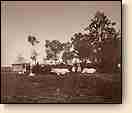
|

"At the entrance of the camp, the eye embraces an immense panorama of tents
rolling fluidly over the landscape like an enormous flock of sheep, broken only
by pine tree beds. The first are magazines housed in good, solid barracks, the
warehouses that function continuously, the ovens that bake the bread every day,
the gigantic rounds of grain, the park where the cows from Switzerland and
Hungary are grouped. Just beyond this, the artillery displays its lines
of canon symmetrically arranged, its caissons, and its wheeled carriages drawn
by magnificent horses ". Fairly "Spartan" when the camp was inaugurated in
1857, the billets were improved from year to year. Each billet was bordered by
the color-line on which the arms were piled and marked by the flagpole monument
of the regiment. The gardens were cultivated.
"All of the cavalry, the artillery, their train, were grouped on the two
sides of the river in order to be close to the watering places. Further along,
the infantry divisions spread out along the left bank of the Cheneu and the
closest possible to their bed. Bordering the color-line of the two infantry
divisions, we find the zouaves, the grenadiers, the light infantrymen. This
line is at least four kilometers long." Each company had two rows of tents,
separated by a large 20-meter wide street; the companies were separated by
streets roughly two meters wide; each tent could hold sixteen men maximum; the
officers of the company were in the three rows of tents at the reart,
dominated by the marquise tent of the colonel".
|



